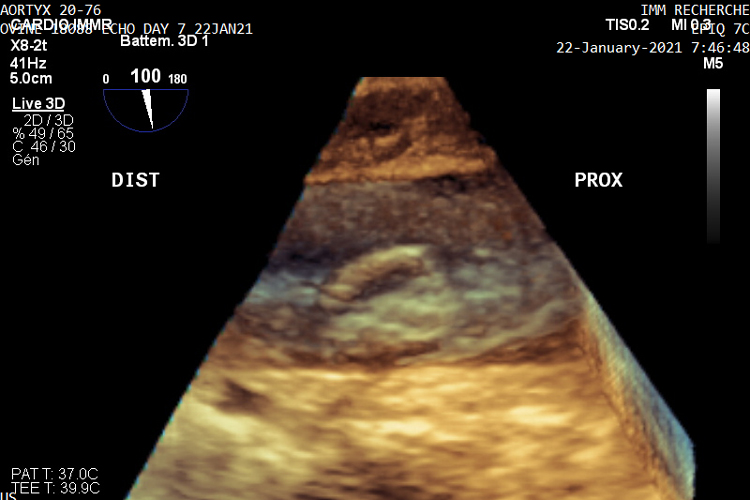IQS researchers of the Endovascular Repair Patch project, carried out within the AGAUR ‘Product’ call, have achieved both the definitive design of the deployer and the biocompatible materials that allow the administration of a patch for the repair of arteries affected by aortic dissection .

Image of the patch attached to the aorta of a live sheep (3D Transesophageal Ultrasound)
Endovascular Repair Patch is a project that has been carried out by IQS researchers within the "Product" call for projects (2018) by the Agència de Gestió d'Ajuts i de Recerca (AGAUR) – Government of Catalonia Industry Knowledge Programme. The objective of the "Product" call is to finance projects aimed at obtaining prototypes, as well as to assess and transfer the results obtained in the research.
In the case of the Endovascular Repair Patch (ERP), closed in January 2021, the objective was to address the problems associated with aortic dissection, a cardiovascular disease that causes the rupture of the aortic artery, which is a common condition across the globe and for which there are no specific treatments. The technology transfer developed in the Endovascular Repair Patch is being carried out at Aortyx, a spin-off led by IQS researchers and the Hospital Clínic de Barcelona.
Successful results achieved
The solution proposed in this project is a graft in the form of an adhesive patch, prepared with a biodegradable material that imitates the mechanical properties of the artery and enables its regeneration without having to resort to invasive surgeries.
In the eighteen months the ERP project was carried out, the researchers have achieved three remarkable results achieved in tests conducted on aorta models, on pigs, and in human aortic cells:
- Various formulations were obtained for the adhesive, with materials that are not toxic to human aortic cells.
- In tests on pigs, the researchers were able to make the patch not cause clots and for it to attach perfectly in the aorta.
- Finally, the definitive design of the endovascular catheter was produced, which allows access to the damaged region in a minimally invasive manner, unfolds like an umbrella, and administers the patch to the patient.
In addition, the patent application for the deployer has been filed, which is currently in the PCT phase.
Three research groups were involved in the ERP project
The project has been carried out by members of three research groups within the IQS School of Engineering: the Vascular Engineering and Bioengineering Group (GEVAB) led by Dr Jordi Martorell, the Materials Engineering Group (GEMAT) coordinated by Dr Salvador Borrós, and the Industrial Products Engineering Group (GEPI) headed by Dr Andrés García.
GEVAB and GEMAT researchers have been responsible for developing the materials for the adhesive and the patch that attaches to the artery, as well as all laboratory and animal tests.
Regarding the GEPI group, its researchers were responsible for the definitive design of the deployer and its catheter.
In the words of Dr Jordi Martorell, “it has really been a cross-cutting project and we have achieved great results thanks to the constant collaboration between the three research groups. We are extremely pleased."

This project has been co-financed by the European Union through the European Regional Development Fund (ERDF)










